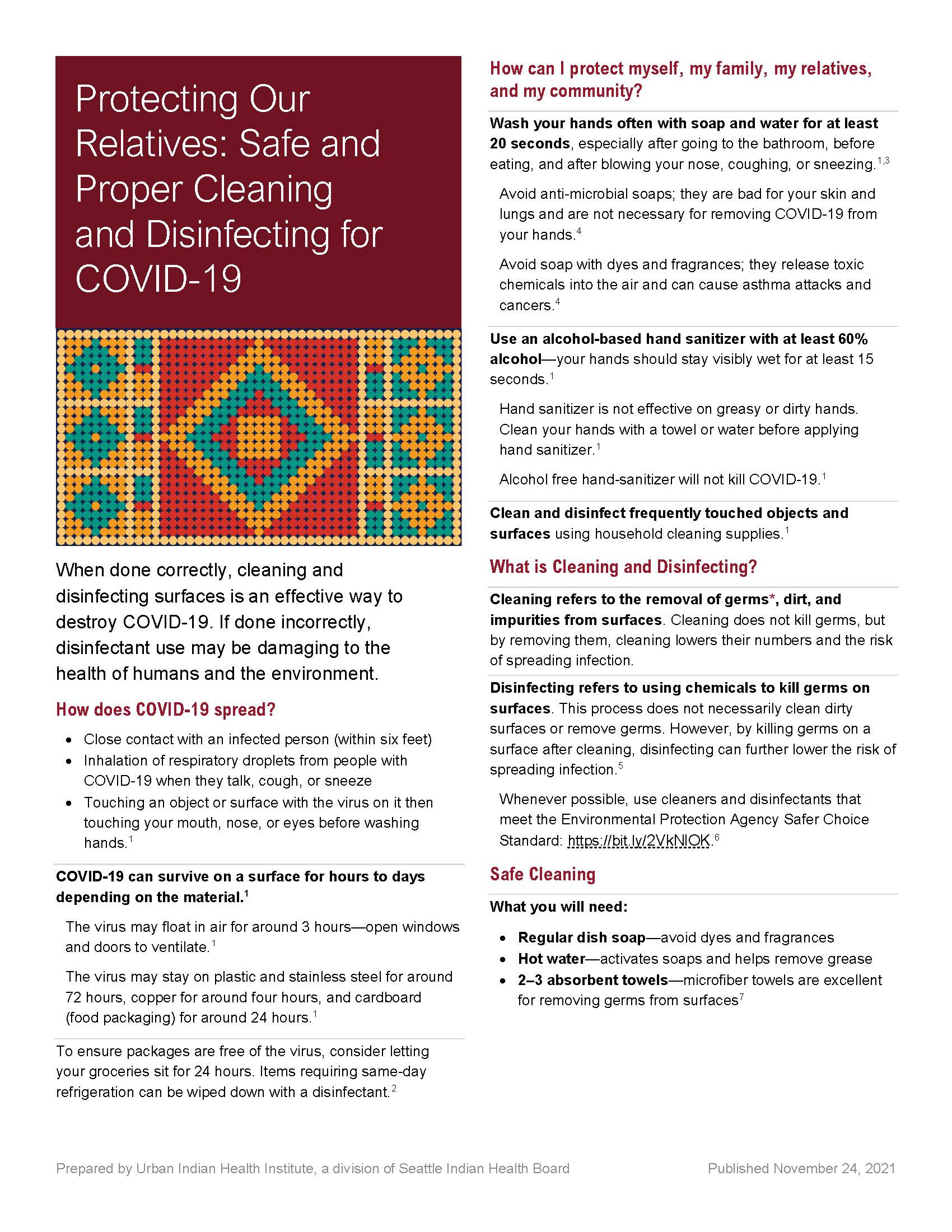When done correctly, cleaning and disinfecting surfaces is an effective way to destroy COVID-19. If done incorrectly, disinfectant use may be damaging to the health of humans and the environment.
How does COVID-19 spread?
- Close contact with an infected person (within six feet)
- Inhalation of respiratory droplets from people with COVID-19 when they talk, cough, or sneeze
- Touching an object or surface with the virus on it then touching your mouth, nose, or eyes before washing hands
COVID-19 can survive on a surface for hours to days depending on the material.
The virus may float in air for around 3 hours—open windows and doors to ventilate.
The virus may stay on plastic and stainless steel for around 72 hours, copper for around four hours, and cardboard (food packaging) for around 24 hours.
To ensure packages are free of the virus, consider letting your groceries sit for 24 hours. Items requiring same-day refrigeration can be wiped down with a disinfectant.
How can I protect myself, my family, my relatives, and my community?
How can I protect myself, my family, my relatives, and my community?
Wash your hands often with soap and water for at least 20 seconds, especially after going to the bathroom, before eating, and after blowing your nose, coughing, or sneezing.
Avoid anti-microbial soaps; they are bad for your skin and lungs and are not necessary for removing COVID-19 from your hands.
Avoid soap with dyes and fragrances; they release toxic chemicals into the air and can cause asthma attacks and cancers.
Use an alcohol-based hand sanitizer with at least 60% alcohol—your hands should stay visibly wet for at least 15 seconds.
Hand sanitizer is not effective on greasy or dirty hands. Clean your hands with a towel or water before applying hand sanitizer.
Alcohol free hand-sanitizer will not kill COVID-19.
Clean and disinfect frequently touched objects and surfaces using household cleaning supplies.
What is Cleaning and Disinfecting?
Cleaning refers to the removal of germs*, dirt, and impurities from surfaces. Cleaning does not kill germs, but by removing them, cleaning lowers their numbers and the risk of spreading infection.
Disinfecting refers to using chemicals to kill germs on surfaces. This process does not necessarily clean dirty surfaces or remove germs. However, by killing germs on a surface after cleaning, disinfecting can further lower the risk of spreading infection.
Whenever possible, use cleaners and disinfectants that meet the Environmental Protection Agency Safer Choice Standard.
Safe Cleaning
What you will need:
- Regular dish soap—avoid dyes and fragrances
- Hot water—activates soaps and helps remove grease
- 2–3 absorbent towels—microfiber towels are excellent for removing germs from surfaces
Step-by-step:
- Completely soak a clean towel in hot, soapy water.
- Use towel to scrub surface in a grid-like pattern to ensure you are cleaning the entire surface. Agitation removes virus from surface.
- With a new wet towel (not soapy), wipe down the surface to rinse and remove leftover soap and germs.
- Thoroughly dry the surface with a clean towel. Microfiber towels lift germs off surfaces.
- Repeat this process on all high-touch areas. Consider filling a spray bottle with hot water and soap to clean surfaces inside your car or outdoors.
Safe Disinfecting
What you will need:
- A disinfectant from the Environmental Protection Agency List N. Only these products are approved to kill COVID-19. Disinfectants that use isopropyl alcohol, hydrogen peroxide, L-Lactic Acid, or Citric Acid as active ingredients are less toxic than others
- OR a bleach solution to disinfect surfaces. Follow a recipe. NEVER mix bleach or other cleaning and disinfecting products together. This can cause fumes that are extremely dangerous to inhale.
Step-by-step:
- Be Safe! Remember, disinfectants are made to destroy living organisms like COVID-19, but YOU are also a living organism. Read and follow product labels; it’s the law!
- Wear personal protection—try to wear disposable gloves when using disinfectants
- Make sure your space has good ventilation. Open windows and turn on a fan to protect your lungs and everyone else in the household.
- Ensure surface is visibly wet for the required contact time—look on the label for specific product contact time. Never spray disinfectants into the air. This will not disinfect the air and only releases harmful chemicals. After disinfecting surfaces used for food preparation or surfaces children play on, use a wet cotton towel to rinse and remove harmful chemicals.
- Disinfectants are for use on surfaces, not humans. Do not ingest or inject any type of disinfectant or cleaner. Keep all disinfectants out of the reach of children. Poison Control call line: 1 (800) 222-1222 In an emergency, call 911.
References
- How coronavirus spreads. Centers for Disease Control and Prevention. https://www.cdc.gov/coronavirus/2019-ncov/prevent-getting-sick/how-covid-spreads.html. Accessed November 23, 2021.
- Center for Food Safety and Applied Nutrition. Shopping for food during the COVID-19 pandemic. U.S. Food and Drug Administration. https://www.fda.gov/food/food-safety-during-emergencies/shopping-food-during-covid-19-pandemic-information-consumers. Accessed November 23, 2021.
- TodayShow. Songs to wash your hands to when 'happy birthday' doesn't cut it. TODAY.com. https://www.today.com/health/songs-sing-while-washing-hands-coronavirus-hand-washing-songs-t175755. Published March 11, 2020. Accessed November 23, 2021.
- Thhn webinar: Safe and proper use of disinfectants & household cleaners. Northern Arizona University. https://mediaspace.nau.edu/media/THHN%20Webinar%3A%20Safe%20and%20Proper%20use%20of%20Disinfectants%20%26%20Household%20Cleaners/0_gywugqfv. Accessed November 23, 2021.
- Cleaning and disinfecting your home. Centers for Disease Control and Prevention. https://www.cdc.gov/coronavirus/2019-ncov/prevent-getting-sick/disinfecting-your-home.html. Accessed November 23, 2021.
- EPA. https://www.epa.gov/saferchoice/products. Accessed November 23, 2021.
- COVID-19 Residue Free Cleaning from My Kitchen to Your Home. YouTube; 2020. https://www.youtube.com/watch?v=RRtUnVAVBBo. Accessed November 23, 2021.
- Ben-Joseph EP, ed. What are germs? (for kids) - nemours kidshealth. KidsHealth. https://kidshealth.org/en/kids/germs.html?ref=search. Published May 2020. Accessed November 23, 2021.

